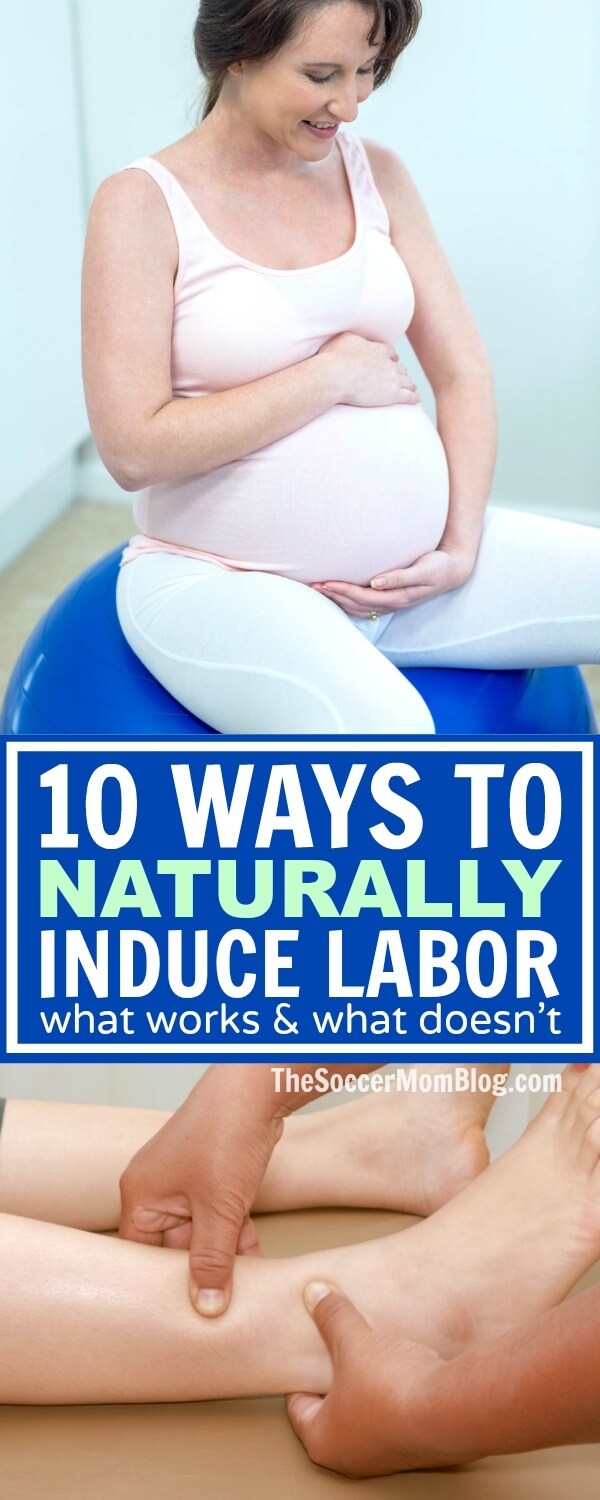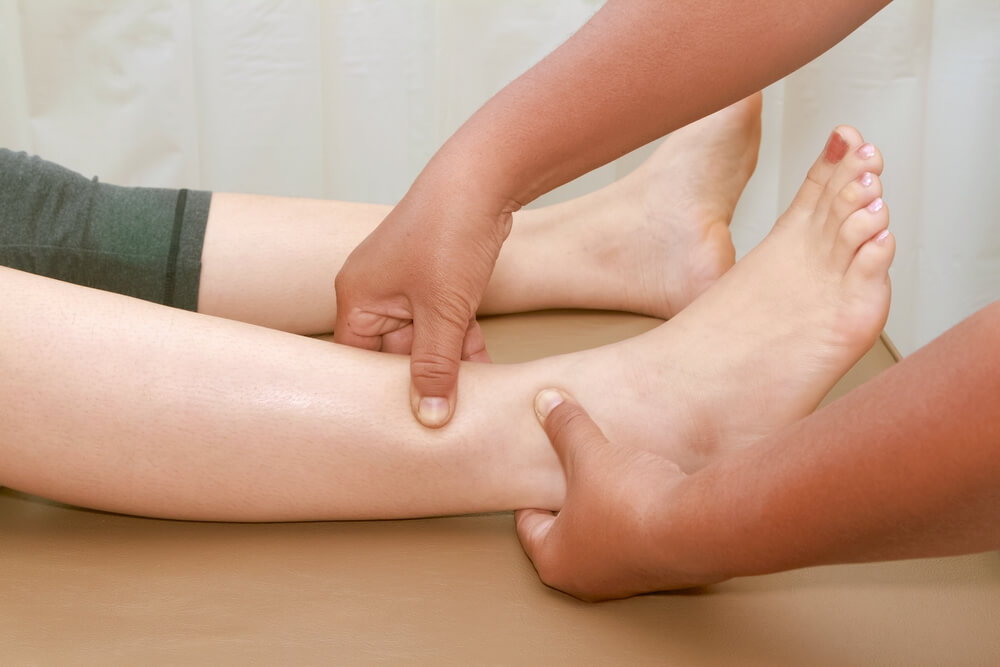What’s inside: A breakdown of popular natural ways to start labor if you are hoping to avoid a medical induction. Practicing these during the third trimester of pregnancy may help kick-start labor and a smoother delivery. We’ll also share what didn’t work as well!
Though it’s been a couple years since I went through the whole childbirth thing, I recently read a post by fellow local blogger Paula at Beauty through Imperfection where she talked about the induction methods that worked (and didn’t) for her.
It brought back a lot of memories, so I thought it would be fun and helpful to detail all the things I tried to start labor naturally.
Since I went 8 days past my due date, I attempted a LOT of different “tricks” and techniques recommended by my midwife, childbirth resources, and even online mommy groups.
Keep in mind that this post is based on my own personal experience, and that results may vary for other mamas. My goal is to explain some of the natural ways to induce labor, so you can decide if they are worth trying. Always check with your doctor/midwife before starting any labor induction techniques.
10 Natural Ways to Start Labor
The following are all things I did to try to induce labor without medical interventions. There were a couple that worked, and many that didn’t. Your results may vary, but this will hopefully give you a good idea of the most common options out there and what they entail.
Affiliate links provided for your convenience; full disclosure policy available here.
1. Bouncing on a Yoga Ball
What the experts say — This is one of the most common suggestions for starting labor or encouraging your baby to assume the correct birthing position. My midwife told me to bounce, bounce, bounce!
What I tried — Sitting on top of an inflatable, yoga exercise ball with feet firmly on the ground, I bounced gently for about 15-30 minutes at a time.
While this became our go-to trick for “rocking” our baby to sleep once she was out of my belly, bouncing did nothing to encourage her to leave when she was inside. In fact, I think I bounced so much that it’s why she would only fall asleep bouncing for almost a year postpartum!
How much did I bounce? Probably a combined 1-2 hours every day by the last few weeks. It was a lot of bouncing.
Verdict: Good exercise, and perhaps it kept my core strengthened, but didn’t start labor.
2. Side-stepping
What the experts say — Recommended by my midwife, this involved standing next to a curb or a step, then stepping up sideways with one foot, then stepping back down. It was supposed to help encourage my little one to move to the ideal position for birth.
What I tried — I’m not sure if it made any difference and it was pretty awkward. However, by the time I was 10 months pregnant, I was hardly able to do any physical activity, so if nothing else, these sidesteps were a form of exercise.
Verdict: Again, useful for exercise purposes, but didn’t help induce labor.
Related: 10 Home Remedies to Get Rid of Morning Sickness
3. Crawling
What the experts say — My midwife recommended crawling 10-20 minutes a day (broken up into intervals if necessary) to “rock” my baby into the right position for birth.
What I tried — I crawled circles around our living room rug, because the rest of our house is tile. You’ll definitely want cushioning for your knees due to the added weight from your belly.
Hands-down, my least favorite technique. My huge baby belly made it nearly impossible to move more than an inch at a time, and the weight pulling down on my back was highly uncomfortable.
Since crawling didn’t seem to have any noticeable effect and it was painful, it’s not one I recommend. However, when you’re a week past your due date you’ll try anything once!
Verdict — Uncomfortable, awkward, and sometimes painful. No notable results.
4. Rocking on Hands/Knees
Similar to crawling, but you stay in one place on your hands and knees, rocking back and forth.
What the experts say — This exercise is purported to encourage your baby to move into an ideal position.
What I tried — Since I was carrying 40 pounds of extra weight, I did this on top of my bed. Otherwise it was really tough on my knees.
Verdict — See “crawling.” I hated it.
5. Evening Primrose Oil Capsules
What the experts say — Taken orally or inserted vaginally, some studies show that evening primrose oil may help soften the cervix in preparation for labor and/or shorten the length of labor.
What I tried — My midwife recommended the latter, but with a 40+ pound baby belly in the way, it was impossible for me to do on my own. Even with assistance from my husband (always a trooper), this was an awkward process.
Verdict: Tricky to apply, messy, and supplements can be pricey. Some women swear by evening primrose oil, but I don’t know if it did anything for me.
6. “Doing it”
What the experts say — Science shows that orgasms can stimulate contractions, so many doctors and midwives recommend this natural method.
What I tried — Sorry, no details here 😉
Verdict — I’m not saying it won’t work for you, and you can at least have fun trying! But this wasn’t the magic trick for us.
Related: Click here to see my picks for the best pregnancy pillow, so you can sleep better afterwards!
7. Pressure Points
Chances are, you’ve done some Googling and stumbled across articles about using acupressure points to start labor. But is there any merit to it?
What the experts say — I saw an acupuncturist for pain relief during the last half of my pregnancy. Until the very end, he avoided specific points on my wrists and ankles, as they are said to induce labor. You can also use acupressure (no needles) on these points.
What I tried — In my desperation to start labor during the last couple weeks of my pregnancy, I pressed so hard on my wrists and ankles that I left bruises! When I watched television at night I would apply pressure myself, or ask my husband for help when my hands got tired.
Verdict — Acupuncture was a life-saver for relieving my intense upper rib pain during pregnancy. In fact, it was the only thing that eased my discomfort at all. However, neither acupuncture nor acupressure seemed to do anything for me in the labor-induction department.
8. Membrane Stripping/Sweeping
Membrane stripping or sweeping is a process in which your doctor or midwife uses their finger to separate the amniotic sac from your cervix.
What the experts say — My midwife would not even consider membrane stripping until I was at least a week past my due date. While it is considered by some to be a natural method, as there are no medications involved, it is still an attempt to artificially start labor. Potential risks involve increased chance of further interventions (like a cesarean section) or infection.
What I tried — I asked my midwife to perform a membrane sweep when I was 8 days past my due date. I was miserable and had been experiencing debilitating Braxton Hicks contractions for over a month, leaving me unable to do much of anything.
Verdict — A bit painful, but ultimately effective. Less than three hours later I was in active labor.
9. Walking
What I tried — Walking was the only physical exercise I was capable of by the last month of my pregnancy. I walked every single day around my neighborhood, sometimes twice a day.
While you could say that I walked for weeks with no results, this exercise kept me from gaining more weight than I did and it kept me mobile and healthy. Walking offers so many benefits during pregnancy (and recovery) than starting labor.
However, the morning I had my membrane stripping, I was sent to walk around a nearby Target store until I felt something. After about two hours, contractions picked up and I knew it was time (finally!) So for me, walking following membrane stripping DID work.
Verdict — One of the best exercises during pregnancy; effective for starting labor, especially when used in conjunction with other natural methods.
10. Red Raspberry Leaf Tea
My midwife wouldn’t even let me try red raspberry leaf tea until the day I went in for my membrane stripping, so she obviously thinks it is serious stuff. The taste wasn’t all that bad and I did end up going into labor within a couple hours.
What the experts say — Some studies show that red raspberry lead tea can initiate contractions and/or shorten the duration of labor. (Note: this applies to tea made from real red raspberry leaves, not raspberry-flavored teas).
Verdict — Labor started for me a couple hours after I tried raspberry tea. To be fair, I also had membrane stripping and did a lot of walking that morning.
The Final Verdict: What Worked for Me
When your due date rolls around and there’s still no sign of baby, it’s tempting to try anything to induce labor. However, some natural ways to start labor seem to be little more than old wives tales.
What worked for me was actually a combination of methods: membrane stripping, walking, and raspberry tea. Within a couple hours I had progressed to active labor.
The Drawback to Interventions
It is important for me to include the disclaimer that while I was able to kick-start labor with natural interventions, I ultimately ended up delivering by a c-section.
While I’ll never know for sure, I’ll always wonder if maybe my baby just wasn’t quite ready yet. Perhaps if I had waited a couple more days she would have arrived on her own, maybe even without a surgical birth (which was not my ideal birth experience).
Most of the above induction methods are harmless. So even if they don’t work, they don’t have any side effects. However, membrane stripping is another matter, and one I might not choose if I could “do-over.”
Ultimately, every birth is different, so what worked for me might not work for you. And vice-versa. The most important thing is to listen to your body, keep an open line of communication with your doctor or midwife, and wait. Yep, waiting is sometimes the best thing we can do!
Read more about my birth and postpartum experience:
- 15 Things to Do When You Find Out You’re Pregnant
- My Birth Story
- 5 Things All C-Section Mamas Need to Hear
- Your C-Section Scar: 5 Things to Expect
- What Your Doctor Won’t Tell You About Breastfeeding
- 5 Essential Weight Loss Tips for Breastfeeding Moms
- 7 Tips to Relieve Itchy Skin After Pregnancy
- How to Turn a Posterior Baby Naturally
- Do Postpartum Belly Bands Work?
- The Real Reason Motherhood is Literally Sucking the Life Out of Us
- Paper Chain Octopus Craft - April 24, 2024
- Amish Sugar Cookies - April 19, 2024
- Marshmallow Playdough - April 18, 2024




Stephanie says
So interesting!! I had a membrane strip at 40 weeks and 4 days and then my water broke sitting on a yoga ball that night.
I also drank a ton of Red Raspberry Leaf Tea.
However, I also had to deliver via c-section since contractions never progressed on their own following my water breaking. My water broke on a Thursday and I delivered via c-section on a Sunday, so I definitely tried for a natural birth.
I am currently 39 weeks with my second and have already been feeling practice contractions for weeks, she is in position, but I am leaning toward not doing a membrane strip this time.
Stacey aka the Soccer Mom says
I opted not to do a membrane strip the second time – and my water broke on its own and labor progressed VERY quickly (I think I was 40 weeks and 4 days). I did have to have a 2nd c-section because baby #2 also got stuck. Turns out my pelvic bones do not provide enough space for my big-head babies to pass through. It would have been nice if my first surgeon told me that before I tried for a VBAC! Hopefully your outcome is easier than mine 😉 My midwife says when you have a c-section because of “failure to progress,” your chances for a successful VBAC are higher. Sending positive vibes for a smooth delivery!!